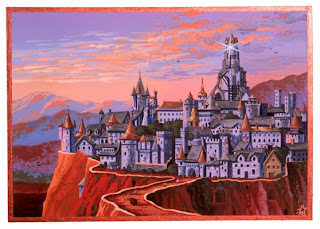To understand this post, you have to imagine that the events and characters I am talking about actually existed, even though I assure you they didn't. They may have been based on real things and people, but they were part of a story I created in the 1970s, wrote about in the 1970s and 80s, and then forgot. My notes from my journals in the early 70s are bringing some of it back.
Loukas Chiaramonti, the man in the library some posts back, lived a long and varied life. When I "met" him in Europe and at Harvard, he was in his 50s and already an Eastern Orthodox monk. He may also have been ordained a priest by that time. The drawings on this page show Loukas as a professor of Byzantine and Orthodox studies at a guest semester at Oxford. The other man in the picture was named Elie Clemenko and was an Ukrainian graduate student temporarily allowed to study at Oxford. This may be the only appearance of Clemenko in the storyline, a minor character who returned to the then Soviet Union.
Loukas was a formidable presence, about six feet tall and usually dressed in either black clerical garb or a dusty black Orthodox monk robe. He wore a cylindrical black hat on his bald head. Though he was the picture of Orthodox Christian asceticism, I found that he knew quite a lot about music, gourmet food, poetry, and other worldly things. By talking with people who knew him and were happy to offer information, I traced his life from his Venetian origin to his current (1973) temporary teaching job at Harvard. It turned out that during the war (World War II) he had been in Greece studying Orthodox liturgy and history during the Nazi occupation. He had joined the Resistance where he had been wounded (he still walked with a slight limp).
After some time in America after the war, he returned to Greece where, to my surprise, he married a Greek woman. This was during the 1950s. By the early 1960s though, they were divorced when she left him, complaining about his obsession with religion and monasticism. (Divorce is permissible in Eastern Orthodoxy.) He emigrated to America again and spent most of the 1960s in a peculiar world of academic bohemia crossed with Eastern Orthodox monasticism and mysticism among the large Greek Orthodox community in the Boston area. By the early 1970s he had expanded his PhD thesis into a definitive work on the Eastern Orthodox liturgy and the role of the "holy word."
Here's another, more formal picture of him, excerpted from a group portrait I did in 1973. Painted in gouache (opaque watercolor).
I was certainly not close to him but I did attend many of his lectures and I confessed to him that I wanted to convert to Christianity. As I said before, Loukas became an ideal to me but his influence did not keep me within the academic fold. I lost contact with him by the mid-seventies.
There's lots more about Loukas but I'll spare you further details at least for now.
Loukas Chiaramonti journal page is ink and watercolor on sketchbook page, about 8 1/2" x 11", August 1973. Click for larger view.













































